Vank Cathedral | Persian & Armenian Cultural Masterpiece
Vank Cathedral, an architectural gem nestled in the heart of Isfahan, Iran, stands as a testament to the rich history and cultural diversity of the region.
With its fusion of Armenian and Persian influences, the cathedral has become a symbol of religious harmony and artistic brilliance. The Vank Cathedral, also known as the Holy Savior Cathedral, carries immense historical and religious significance for the Armenian community in Iran and serves as a popular tourist attraction for visitors worldwide.
In this article, we introduce you to one of the architectural masterpieces: Vank Cathedral.
Historical Background

Vank Cathedral, also known as the Holy Savior Cathedral, is situated in the enchanting city of Isfahan, Iran. The city, historically known for its prosperity and cultural significance, became home to a flourishing Armenian community in the early 17th century. The cathedral's location within the heart of Isfahan was no coincidence; it was strategically chosen to create a sense of unity and belonging among the Armenian diaspora.
The Armenian community in Isfahan can trace its roots back to the 5th century when Armenians fled persecution in their homeland and sought refuge in various regions. Throughout history, Isfahan emerged as a prominent destination for Armenian immigrants, who contributed significantly to the city's trade, arts, and culture.

In the 17th century, under the reign of Shah Abbas I, Isfahan experienced a golden age, transforming into a major cultural and trade hub. Shah Abbas I, recognizing the Armenians' skills and contributions, granted them permission to settle in the area known as "New Julfa," named after their original hometown in Armenia.
The establishment of New Julfa provided the Armenian community with a safe haven to practice their faith freely. Within this thriving community, Vank Cathedral was erected as a symbol of their resilience and devotion to their Christian beliefs.
Vank Cathedral's Construction and Development
Vank Cathedral's construction began in 1606 under the supervision of Archbishop David, an influential leader in the Armenian community. Skilled Armenian and Persian architects collaborated on the design, resulting in an exquisite blend of styles that showcased the unity between the two cultures.
Over the years, Vank Cathedral underwent various expansions and renovations, each stage adding to its grandeur and splendor. The cathedral's construction and development coincided with significant historical events, such as political changes, wars, and social transformations.
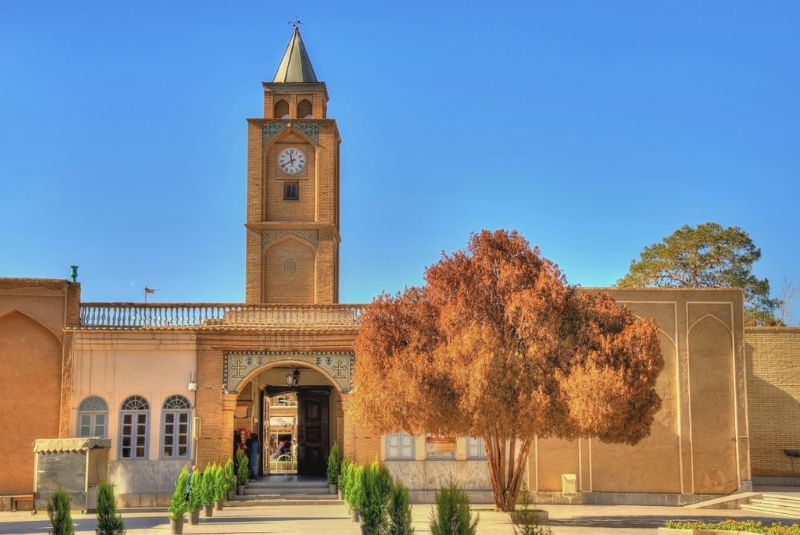
During the reign of Shah Abbas II, the cathedral faced the threat of destruction. However, the quick-witted Armenian community rallied together and presented the king with a magnificent carpet woven with images of paradise, thus persuading him to spare the cathedral.
In the following centuries, the cathedral continued to play a central role in the lives of the Armenian community in Isfahan, serving as a place of worship, education, and cultural preservation. The interior artwork and decorations evolved, reflecting the evolving tastes and artistic styles of different eras.
Today, Vank Cathedral remains a living testament to the resilience and unity of the Armenian community in Iran. It's historical significance and architectural brilliance attract visitors from around the world, offering them a glimpse into a rich tapestry of cultural heritage and spiritual devotion.
As Vank Cathedral stands tall amidst the bustling streets of Isfahan, it serves as a reminder of the enduring power of faith, culture, and art, bridging the divide between the Armenian and Persian traditions in a harmonious and captivating manner.
| Suggestions: Do Iranians Celebrate Christmas?
Architectural Marvels
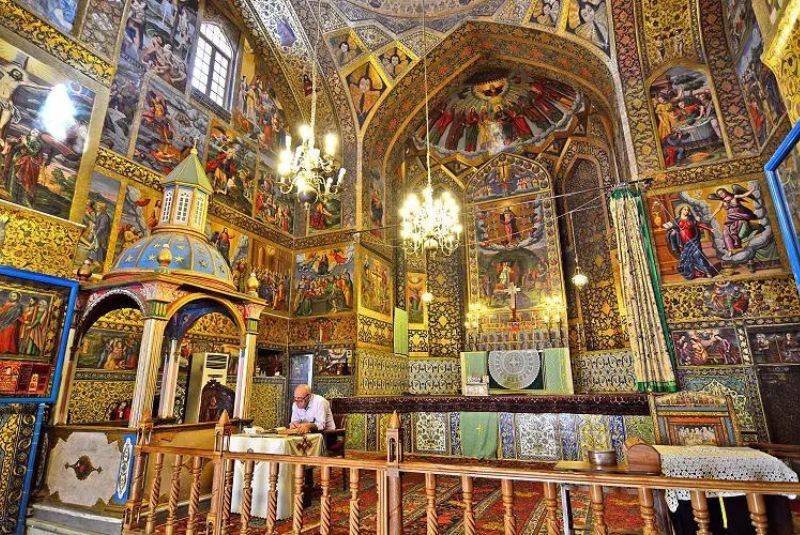
Vank Cathedral's exterior stands as a testament to the exquisite craftsmanship and architectural brilliance of its time. The cathedral is an imposing structure with a facade that exudes both grandeur and elegance. Its ochre-colored walls, adorned with delicate tile work, create a captivating visual spectacle.
The entrance of Vank Cathedral is a marvel in itself, featuring intricate arches and beautifully carved motifs that welcome visitors with a sense of reverence. Above the entrance, a stunning large cross stands as a symbol of the cathedral's Christian identity.
As one gazes up, the cathedral's dome dominates the skyline of Isfahan, proudly declaring its presence amidst the surrounding buildings. The dome's blue hues contrast with the earthy tones of the walls, creating a harmonious color palette that reflects the fusion of Armenian and Persian influences.
| Also might be interesting: Top 16 Most Beautiful Mosques in Iran
Unique Blend of Armenian and Persian Architectural Styles
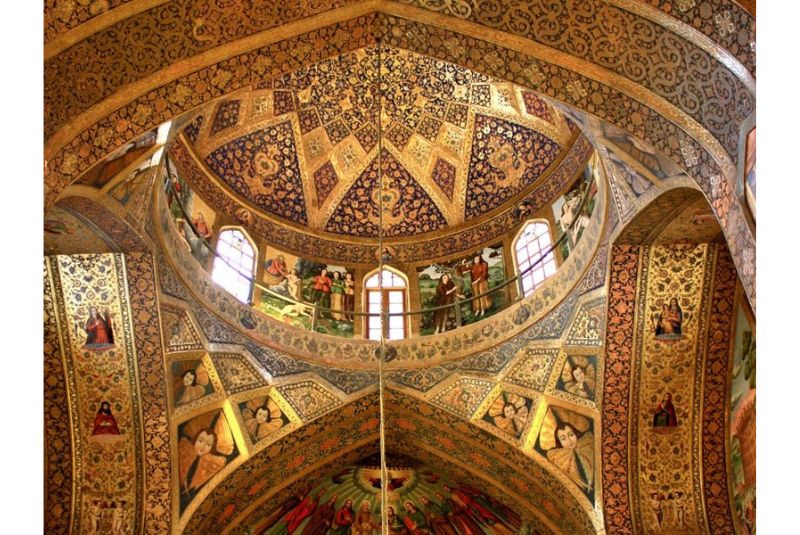
Vank Cathedral's architecture is a captivating blend of Armenian and Persian elements, showcasing the harmonious coexistence of these two rich cultures. The fusion of styles is particularly evident in the cathedral's dome, which incorporates the traditional Armenian drum structure adorned with Persian-style turquoise tiles.
The interior layout follows the Armenian architectural tradition, emphasizing a basilica design with a central nave and two side aisles. This layout complements the Persian architectural style seen in the decorative details and tile work, creating a seamless integration of the two influences.
The cathedral's incorporation of Persian tile mosaics, geometric patterns, and arabesque designs within the Armenian architectural framework represents a harmonious union of artistic expressions from both cultures. This unique amalgamation serves as a symbol of the close relationship between the Armenian community and their Persian hosts.
Features and Elements of the Vank Cathedral
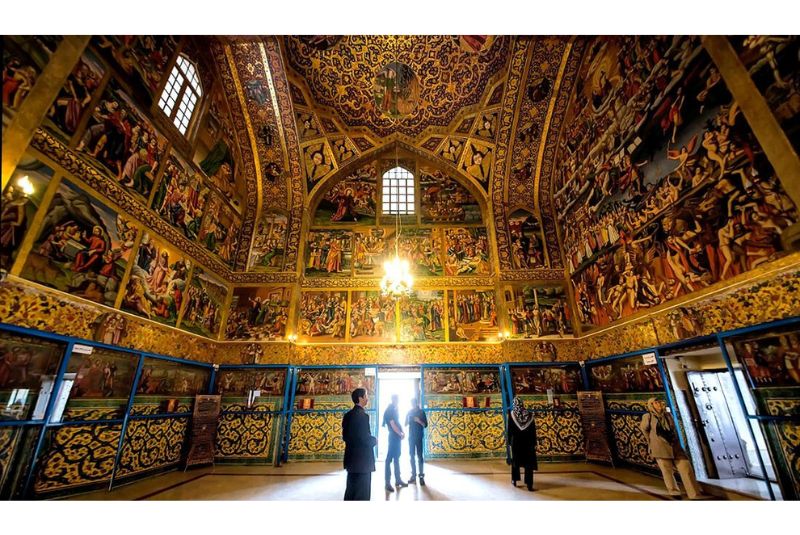
Within the cathedral's interior, visitors are welcomed into a world of breathtaking splendor and spiritual significance. The high-vaulted ceilings are adorned with elaborate frescoes depicting religious narratives from the Bible and Armenian Christian history. These stunning artworks narrate stories of faith, struggle, and triumph, captivating the hearts of all who behold them.
The cathedral's altar, located at the eastern end, is a focal point of worship and devotion. The intricately carved wooden altar screen, known as an iconostasis, separates the sanctuary from the nave, emphasizing the sacredness of the space. This wooden masterpiece is adorned with religious icons and serves as a tangible representation of the spiritual connection between heaven and earth.
Another prominent feature is the cathedral's remarkable collection of religious artifacts, including ancient manuscripts, illuminated gospels, and intricately designed chalices. These treasures offer a glimpse into the spiritual and cultural heritage of the Armenian community.
As visitors explore Vank Cathedral, they are mesmerized by the delicate tile work and calligraphy that embellish the walls and archways. The designs beautifully complement the frescoes, creating an immersive experience of art and spirituality.
| Discover: Famous Churches in Iran
Interior Splendor
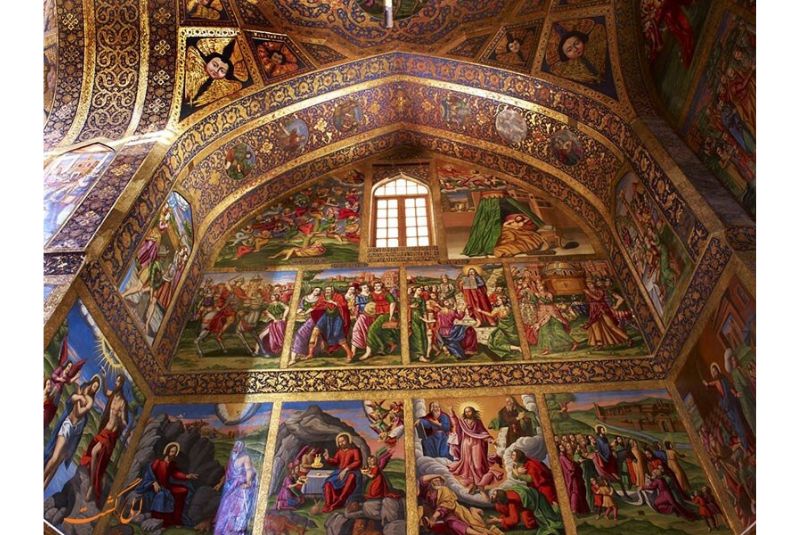
Stepping into the hallowed halls of Vank Cathedral, visitors are instantly transported to a world of unparalleled beauty and spirituality. The interior design reflects the meticulous planning and artistic brilliance that went into creating this awe-inspiring sanctuary.
The central nave, flanked by two side aisles, follows the traditional basilica design, providing an open and inviting space for worshippers. The high-vaulted ceilings, adorned with elaborate patterns and delicate stucco work, create an aura of elegance and grandeur. The space is carefully illuminated by stained glass windows, casting colorful rays of light that dance upon the floors and walls.
| Discover: Isfahan Mosques You Should Visit
Breathtaking Frescoes, Mosaics, and Intricate Artwork
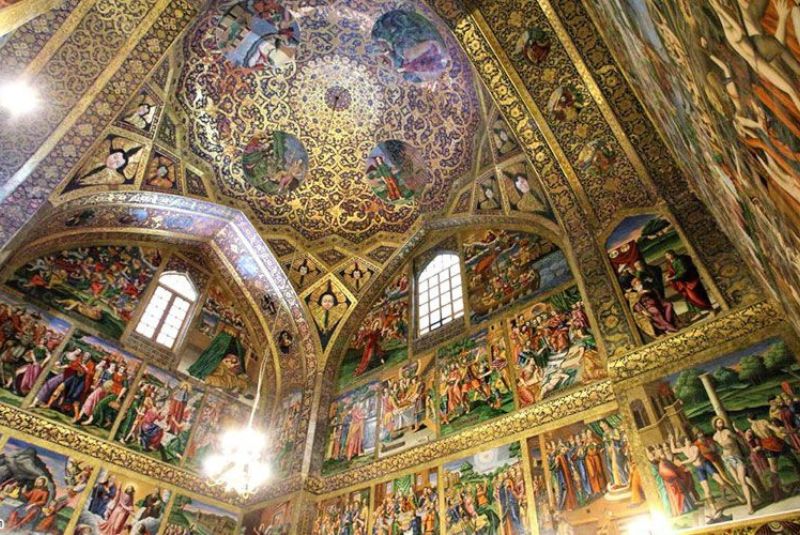
The frescoes adorning the walls of Vank Cathedral are a breathtaking sight to behold. Each fresco tells a compelling story from biblical scriptures and Armenian Christian history. The vivid colors and intricate details bring these narratives to life, immersing visitors in the events of the past and the lessons they hold.
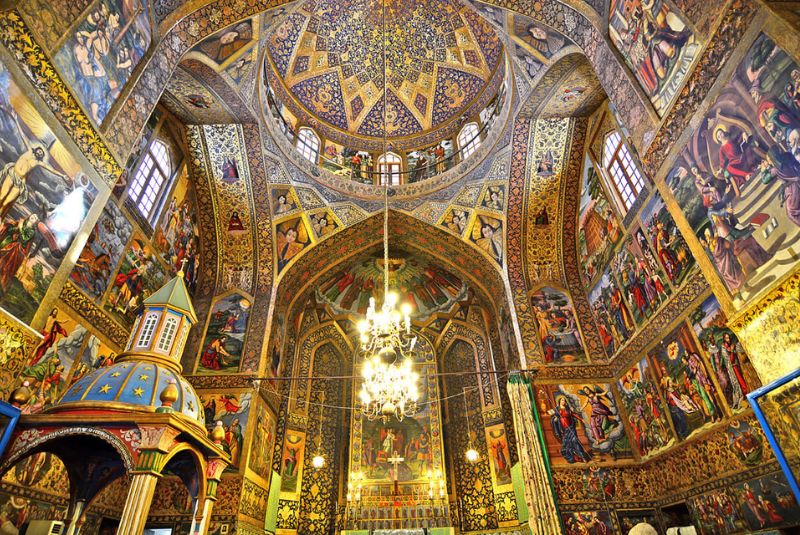
Mosaics, another exquisite form of artwork found within the cathedral, decorate the archways and domes. The mosaics showcase intricate patterns and designs, incorporating a vibrant array of colors and materials. These mosaics, skillfully crafted by talented artisans, serve as a testament to the meticulous craftsmanship of the time.
In addition to frescoes and mosaics, the cathedral houses an impressive collection of religious paintings and sculptures. The delicate artwork adorning the altar and other sacred spaces speaks of the profound devotion and reverence of the artists and the worshippers who contributed to the cathedral's splendor.
| Read more: 16 Most Beautiful Mosques You Should Visit
Religious Symbolism Depicted Throughout the Interior
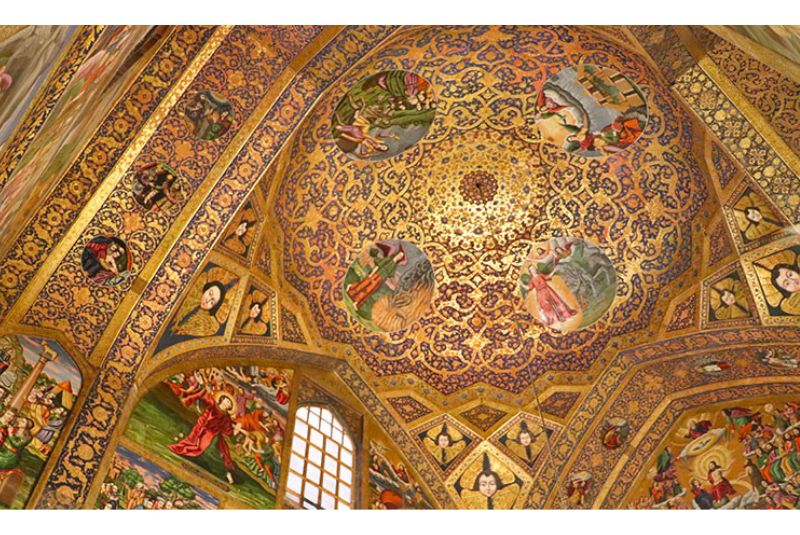
Religious symbolism is woven intricately into every aspect of Vank Cathedral's interior. The altar, the focal point of the cathedral, symbolizes the sacred space where the divine and the earthly realms meet. The iconostasis, with its array of religious icons, represents the bridge between the congregation and the holy sanctuary, serving as a connection to the divine.
The frescoes and mosaics are laden with religious symbolism, conveying spiritual teachings and moral lessons. Scenes from the life of Jesus Christ, the Virgin Mary, and various saints adorn the walls, inviting worshippers to contemplate the virtues and values espoused by their faith.
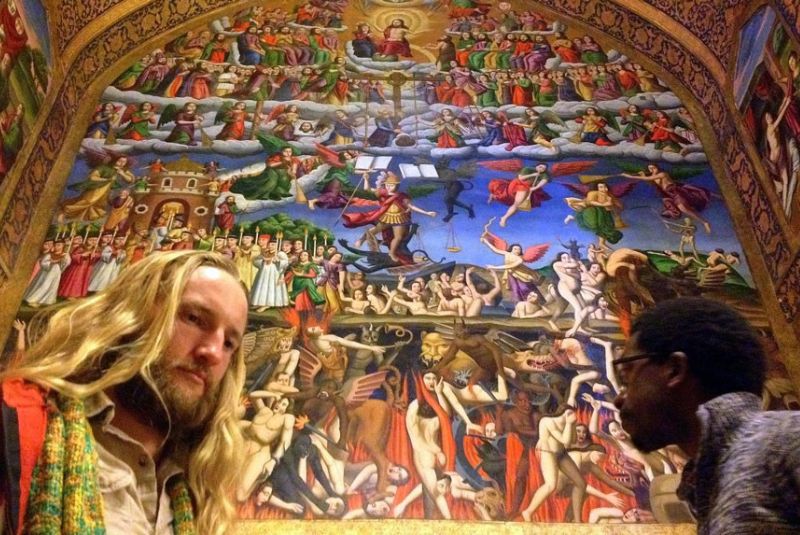
The stained glass windows, with their vibrant hues, cast a mesmerizing play of colors within the cathedral. These windows, often depicting biblical scenes and heavenly imagery, serve as a metaphor for the divine light illuminating the hearts and souls of the faithful.
The use of geometric patterns and arabesque designs throughout the interior carries symbolic significance. Geometric patterns are a reflection of the divine order and harmony in the universe, while arabesque designs symbolize the infinite and boundless nature of God's love.
Religious and Cultural Significance
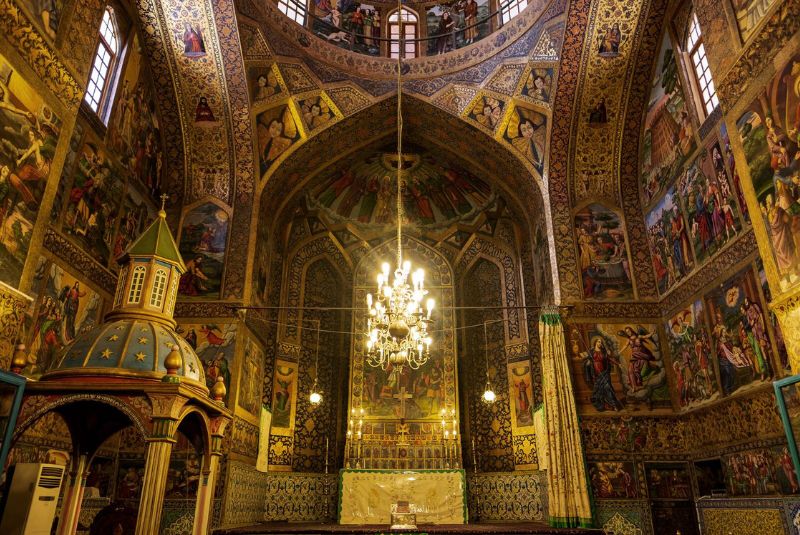
Vank Cathedral holds immense importance in preserving and celebrating the Armenian culture and identity in a foreign land. As one of the earliest symbols of the Armenian community's presence in Isfahan, the cathedral has served as a cultural hub, fostering a sense of unity and belonging among the Armenian diaspora.
Throughout history, the cathedral has been more than a place of worship; it has been a center for education, language, and arts. The Armenian community utilized the cathedral as a place to teach their language, music, and traditional crafts, ensuring that their cultural heritage thrived and was passed down to future generations.
The religious services held at Vank Cathedral incorporate traditional Armenian liturgical practices, preserving ancient rituals and hymns that have been part of Armenian Christian worship for centuries. By maintaining these traditions, the cathedral plays a vital role in safeguarding the distinct cultural identity of the Armenian community.
| Read more: St. Mary Armenian Church
Religious Ceremonies Held at the Vank Cathedral
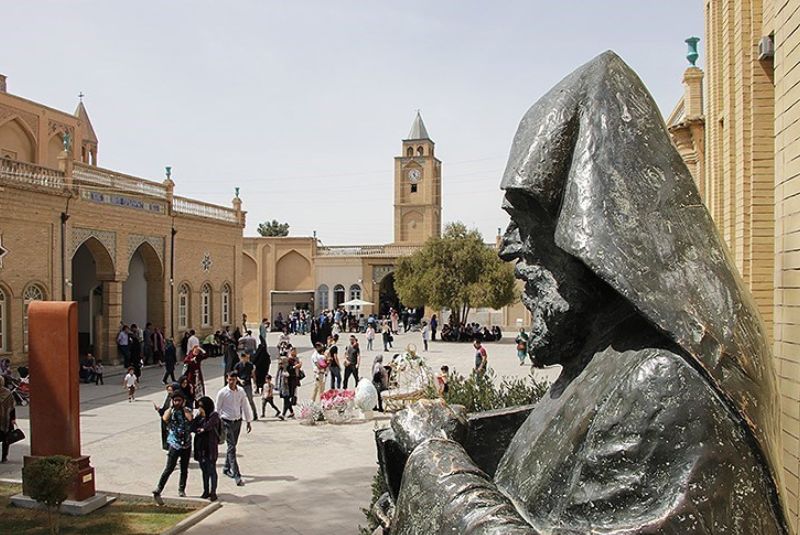
Vank Cathedral is a vibrant spiritual center where religious practices and ceremonies are carried out with great reverence. Regular religious services, including Holy Mass, are conducted in accordance with Armenian Apostolic traditions, providing a spiritual refuge for Armenian Christians living in Isfahan and beyond.
One of the significant religious events celebrated at Vank Cathedral is Easter, known as "Zatik" in Armenian. The cathedral becomes alive with jubilant hymns and prayers, and worshippers come together to commemorate the resurrection of Jesus Christ. The vibrant celebrations attract Armenian Christians from different parts of the world, making it a truly special and joyous occasion.
Weddings and baptisms also hold profound significance at Vank Cathedral. Weddings are not only a union of two individuals but a celebration of Armenian heritage and family ties. Baptisms, known as "Christening," are momentous occasions where Armenian families gather to present their children to the church, marking their initiation into the Christian faith.
Challenges and Preservation Efforts
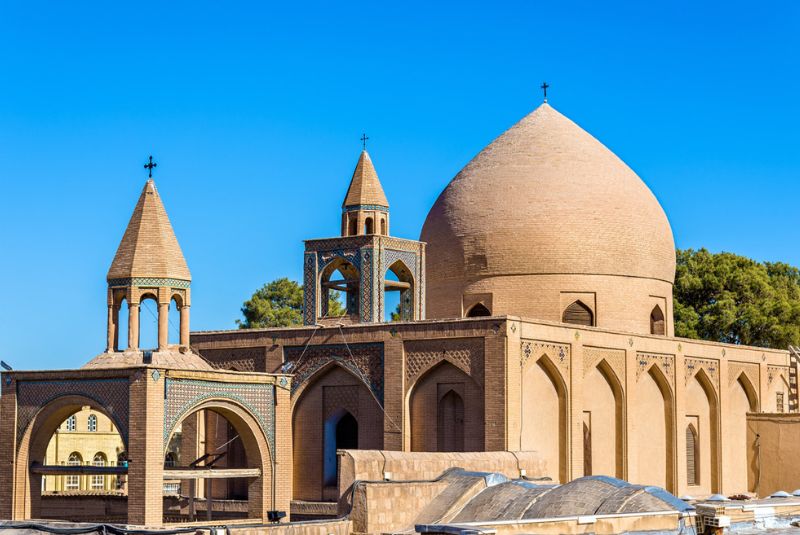
Throughout its long and storied history, Vank Cathedral has faced various challenges that have threatened its existence and cultural heritage. One of the primary challenges was the tumultuous political landscape and conflicts that occurred during different periods in Iran's history.
During the Safavid dynasty, which saw the cathedral's construction, the Armenian community enjoyed relative stability and protection. However, in subsequent centuries, political upheavals and wars posed a threat to the cathedral's survival. At times, Vank Cathedral faced the risk of destruction or desecration, particularly during conflicts that engulfed the region.
Furthermore, natural elements, such as earthquakes and harsh weather conditions, have taken a toll on the cathedral's physical structure over time. These environmental challenges required ongoing efforts to restore and preserve the building's architectural integrity.
Recognizing the historical and cultural significance of Vank Cathedral, concerted efforts have been made to safeguard its heritage and protect it from further degradation. Preservation initiatives have been implemented by local authorities, the Armenian community, and international organizations.
Restoration projects have been undertaken to repair and maintain the cathedral's architecture, including the delicate frescoes, mosaics, and stucco work. Skilled artisans and conservation experts have meticulously worked to ensure that the cathedral's interior splendor is preserved for future generations to appreciate.
Collaborative efforts between the Iranian government and the Armenian community have been instrumental in protecting the cathedral from potential threats. The cathedral's importance as a symbol of religious harmony and cultural heritage has garnered the support of various stakeholders, ensuring that it remains a cherished historical monument.
| Related: Qara Kelisa | The Armenian Monastic Ensembles of Iran
Impact on Tourism
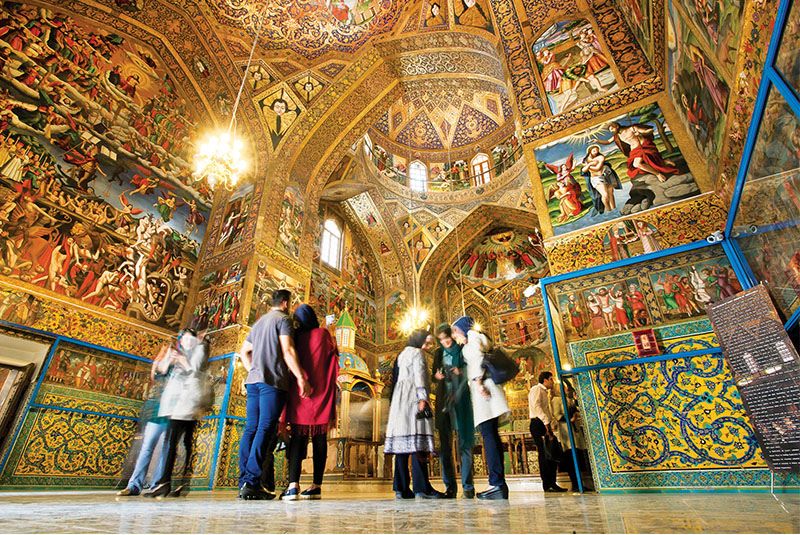
Vank Cathedral's architectural splendor and rich historical significance have made it a highly sought-after tourist attraction in Isfahan, Iran. Every year, thousands of visitors from all corners of the world flock to the city to marvel at the beauty and cultural heritage that the cathedral embodies.
Tourists are captivated by the unique blend of Armenian and Persian architectural styles showcased in the cathedral's exterior and interior design. The stunning facade, adorned with intricate tile work and elegant arches, serves as a visual feast for art and architecture enthusiasts.
Inside the cathedral, the breathtaking frescoes, mosaics, and religious artwork leave visitors in awe. The delicate craftsmanship and attention to detail exemplify the artistic brilliance of the past and invite visitors to immerse themselves in the spiritual ambiance of the space.
Vank Cathedral's allure as a tourist attraction is not limited to its architectural magnificence. The cathedral's religious and cultural significance adds another layer of appeal. Tourists are drawn to experience the spiritual atmosphere, witness religious ceremonies, and learn about the deep-rooted history and traditions of the Armenian community in Isfahan.
Despite the influx of tourists, the local community has worked to strike a balance between preserving the cathedral's sacredness and allowing visitors to experience its splendor. Guided tours and cultural programs are organized in a manner that respects the cathedral's spiritual sanctity while still offering an enriching experience for tourists.
Bottom Line
Vank Cathedral, the Holy Savior Cathedral, stands as a timeless masterpiece that embodies the enduring spirit of the Armenian community in Isfahan, Iran. Its significance transcends religious and cultural boundaries, serving as a symbol of unity, resilience, and artistic brilliance. Vank Cathedral, with its exquisite design and rich history, stands as an architectural marvel and a testament to the unwavering spirit of the Armenian community in Isfahan.
To all those seeking a profound cultural and spiritual experience, Vank Cathedral beckons you to explore its magnificent halls and immerse yourself in the captivating tales it holds. Whether you are an art enthusiast, a history buff, or a seeker of serenity, a visit to Vank Cathedral will undoubtedly leave an indelible mark on your soul. Let Vank Cathedral be your guide through time, leading you on a journey of discovery and wonder.
Come and be captivated by the splendor of Vank Cathedral – a living testament to the power of the human spirit, artistry, and the enduring legacy of a community's faith and culture.
Share your story!
Comment below and let us know about your Experience.
Your story inspires others!


Comment
Leave a Comment